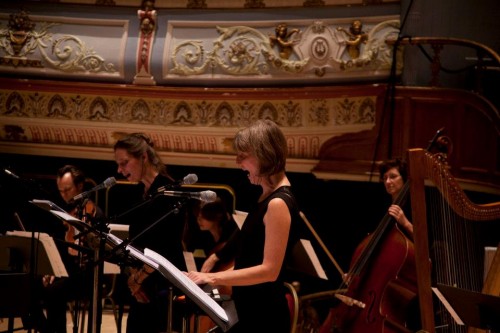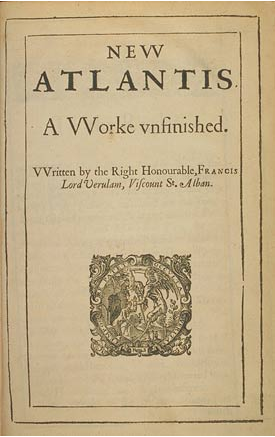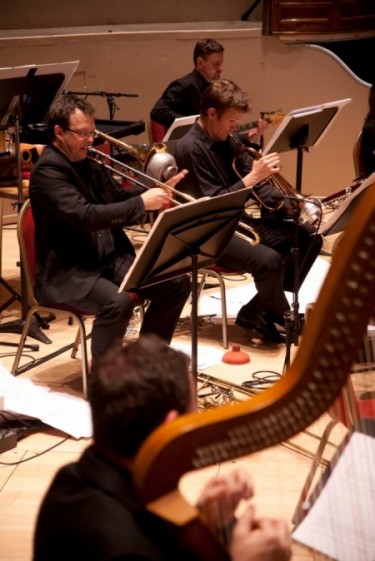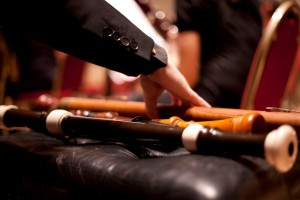The scale of Richard Barrett’s CONSTRUCTION is clearly immense, with 23 performers and well over two hours of music. What is in fact much more remarkable is the richness of content delivered, the frameworks of interaction represented, and the diversity of individual visions of perfection evoked within those constraints. Ten different utopian visions are presented, along with a type of opera and a type of concerto. (In fact, one of the utopia sections, “heliocentric,” includes at least three pre-existent pieces (Aurora, Hypnerotomachia, and Città del sole/Adocentyn), each of which references a separate literary utopia.) Who better than the ELISION ensemble would take on the challenges (logistical, technical, expressive, intellectual…) of this project and follow through with such a richly nuanced and committed performance?
Counterbalancing the array of utopian visions presented throughout the work, human pain and vulnerability is represented in two major strands woven into the work, “Wound” and The Trojan Women. The speeches of these women (each of whom have their own tragedies at the fall of Troy) are full of pathos, portrayed in various sections and moments as hysteria, restraint, despair, supplication, resignation. This strand of the work lasts under half an hour in total, but travels to many extreme corners of the human psyche. The projections of these extremities by Deborah Kayser and Ute Wasserman are compelling, and the two vocalists complement one another, not simply in range, but in their approaches to their instruments.
[all rehearsal photos, credit: Mario Popham. More photos here and here.]
In the pre-concert interview, Barrett spoke of his intent behind “Wound”:
I think the solo violin has a certain kind of presence in our culture as a carrier of heightened emotions, and the title “Wound” actually came from trying to encapsulate for myself that whole kind of feeling. Particularly, it came to my mind when looking at the paintings of Francis Bacon, and the way in which you have these angular juxtapositions of what Bacon called armatures, within which these very disturbing and again, emotionally very intense events seem to be taking place.
These sections, conveyed with virtuosic expressivity by Graeme Jennings, do correlate to the iconic use of the violin in a concerto setting. Barrett has conveyed the essence of the genre, not through orchestration, but through the nature of the foregrounding of the soloist. Similarly, the Trojan Women sections feel operatic because of the drama embedded and conveyed in each of the voice parts.
The first of the utopian sections, “strange lines and distances,” is also the opening of the whole work. It is a series of sonic manipulations of a paragraph read aloud from The New Atlantis, by Francis Bacon (the philosopher in this instance, not the painter). Written in 1623, it is a remarkably prescient vision of the current capabilities of music technology. (As Barrett wrote in the program note, it is “a kind of sonic utopia which can be brought into being now.”)
We have also sound-houses, where we practise and demonstrate all sounds, and their generation. We have harmonies which you have not, of quarter-sounds, and lesser slides of sounds. Divers instruments of music likewise to you unknown, some sweeter than any you have, together with bells and rings that are dainty and sweet. We represent small sounds as great and deep; likewise great sounds extenuate and sharp; we make divers tremblings and warblings of sounds, which in their original are entire. We represent and imitate all articulate sounds and letters, and the voices and notes of beasts and birds. We have certain helps which set to the ear do further the hearing greatly. We have also divers strange and artificial echoes, reflecting the voice many times, and as it were tossing it: and some that give back the voice louder than it came, some shriller, and some deeper; yea, some rendering the voice differing in the letters or articulate sound from that they receive. We have also means to convey sounds in trunks and pipes, in strange lines and distances.
The processing suggested in the text is in large part displayed in the processing of the recording, not as a perfectly literal representation, but as an embodiment of the possibilities envisioned in spatialization, in shifting resonances, and in many more localized details.
“Politeia” follows, and references the society envisioned in Plato’s Republic. It’s a great opening for the instruments, highlighting particular, idiosyncratic playing techniques of each, as the members of Plato’s society each devote themselves to the types of work to which they are best suited. The section also operates as a set of fairly intimate conversations, or zones of activity, amongst the instruments, not unlike the dialogues in Plato’s writings, in which there is room for the characteristics of each participant to be expressed.
In “news from nowhere,” there are slow, relaxed interplays between the winds, percussion, and drones. The author of the book, “News from Nowhere,” William Morris, subtitled the book “an epoch of rest,” and elsewhere wrote that “…the material surroundings of my life should be pleasant, generous, and beautiful; that I know is a large claim, but this I will say about it, that if it cannot be satisfied, if every civilized community cannot provide such surroundings for all its members, I do not want the world to go on.” The music has an exotic, hypnotic, dreamlike beauty.
The “Simorgh” is the mythical bird that is the object of the quest of Farid ud-Din Attar’s “The Conference of the Birds.” (The illustrations by Peter Sis on this new edition of the poem look very, very beautiful.) A key moment arrives at the end of the book and, as I hear it, the end of Barrett’s “Simorgh” section.
Then a change comes over them like a flickering light,
The past petrifies in the dying shadows as the ray
Of Simurgh-bliss rises in them in celestial flight,
And in that vitreous radiance they see His face play
On their own, become one with theirs.
This change reveals itself as an accelerating, frenetic, mystical, progressively more unified quality of ascent. The (acoustic) recorders gradually align with the electronically produced sounds into a single frenzy, leading to the climax and abrupt ending of the section.
I’ve only scratched the surface—outlining some possible correlations to suggest the overwhelming richness of the work and the many corners of human imagination, idealism, and vulnerability that it explores. My own experience of CONSTRUCTION has shifted and deepened each time I’ve engaged with it, and on recently rewatching this video, I understood it from a very different vantage point than I did before I began to find my own route into the piece.
Richard Barrett: CONSTRUCTION from Sound and Music on Vimeo.
In the comments on The Rambler’s post on CONSTRUCTION (which makes some very useful points about the effect of the extreme modularity of the work), Sound and Music have promised, in addition to this introductory video, a 25-30 minute video documenting the performance. I look forward to it.






fantastic, Jennie! Glad i noticed this review, it’s a very good resource, its great how you tracked down a lot of the influences. This blogs getting pretty good!
Thanks David! I’ve really only scratched the surface, but hopefully it’s a start. The work is so compelling, more and more so with deeper engagement.